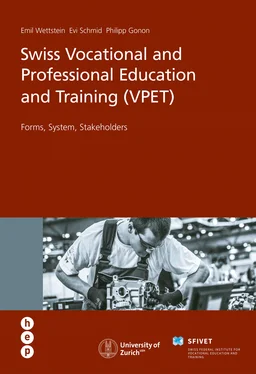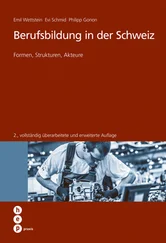Both models have one element in common – in both cases the learners generally change their host company several times. With the host company networks, however, responsibility lies with one of the participating host companies, while with the cooperative training associations responsibility lies with an independent organisation whose main task is not the training itself but rather the management of training (cf. Chapter 3.7, p. 169).
Cooperative training associations are often organised as associations or foundations, and sometimes also as a public organisation, a limited liability company or a joint stock company. The office of the cooperative training association deals with the selection of the learners, supervises the young people and above all ensures that there are enough host companies available to train the learners.
Although they are often contractual partners of the young people according to Article 14 of the Federal Vocational and Professional Education and Training Act (VPETA, 2002), the cooperative training associations do not teach professional practice themselves but rather, in addition to management activities, are responsible for the tasks of the third-party training centre by teaching basic skills in trade schools (full-time vocational schools including work-based training and classroom instruction), training offices or pilot facilities.
The oldest cooperative training association is probably the vocational training centre (Berufsbildungszentrum) SIG Georg Fischer AG in Neuhausen, which was founded in 1993 (today Wibilea AG). Soon, other large companies outsourced their apprentice training departments, including ABB to the Libs association, Novartis (cf. the portrait of Cagdas Guerakar, p. 30) and other chemical companies in the Basel area to Aprentas, Schweizerische Bundesbahnen SBB (Swiss Federal Railways), Rhätische Bahn RhB (Rhaetian Railway), Verkehrsbetriebe Zürich VBZ (Zurich Public Transport) to the Login association, Sulzer to AZW.
To create additional apprenticeship positions, associations, municipalities and socially active organisations like HEKS and Caritas later set up cooperative training associations, usually supported by start-up funds from the Confederation. The Laufbahnzentrum Zürich (Zurich Career Centre) founded the Berufslehr-Verbund Zürich BVZ (Zurich Apprenticeship Association), the Zürcher Schreinermeisterverband (Zurich Master Carpenters’ Association) founded the Verbund Schreinermacher SVZ (Carpenters’ Association). Bildungsnetz Zug (Zug Education Network) and others created associations for two-year VET programmes. Others promote training opportunities in specific occupations, e.g. Uster cooperative training association for telematics technicians, SpedLogSwiss Basel for logistics experts.
The companies Wibilea AG and Klever AG in Winterthur are probably the first joint stock companies active in this business field. Bildxzug provides the opportunity for young people to complete a VET programme in an English-speaking company.
Today, there are small cooperative training associations with five or ten learners but also large companies such as Login with 2,100 learners and Libs with 1,150 learners (2015).
Some cooperative training associations deal with the human resource administration, including the conclusion of the contract and wage payments to the learners, while others concentrate more on preparing the learners for working in the companies by running trade schools (full-time vocational schools, including work-based training and classroom instruction). Aprentas also provides the classroom instruction segment for certain learners. In some associations, the learners are employed by the association during the first part of the VET programme or throughout the entire training period, in others, they are employed at one of the participating host companies.
Cooperative training associations also help solve another problem of modern host companies – the relatively short planning horizon: the obligation for two to four years, which is a consequence of concluding an apprenticeship contract, prevents some companies from training learners.
As Imdorf and Leemann (2010) have shown, the selection behaviour of cooperative training associations differs from that of an SME or a large company. This depends on the goals of the association, however – some pursue social objectives, for example supporting young people with certain weaknesses or disadvantages. Others are oriented mainly towards the needs of the participating companies. Others in turn pursue a more pedagogical goal, for example to enable prospective top athletes to attend a VET programme alongside their sports training.
The terms “host company network” and “cooperative training association” (which incidentally does not appear in the Federal Vocational and Professional Education and Training Act) are not used in a uniform manner. This is also shown by the “Evaluation Lehrbetriebsverbünde” (Evaluation of host company networks), which was carried out in 2007 by the Bundesamt für Berufsbildung und Technologie or BBT (Federal Office for Professional Education and Technology or OPET – today: SERI) (OPET, 2008b).
Cooperative training associations must be understood as an adaptation of company-based VET to the developments in the world of work: they are an expression of a professionalisation of training activities, enable companies to concentrate on their core competences and take a shorter planning horizon into consideration.
In recent years, the establishment of cooperative training associations has made a significant contribution to the expansion of the number of available apprenticeship places and the relatively fast response of the VPET system to changing requirements of the world of work. However, the question needs to be asked whether these associations can continue to be financed in the longer term from funds of the participating companies (Wolter, 2008) or whether sooner or later operating contributions from public funds will be required, which would mean a step towards “school-based VET” (cf. Chapter 1.4, p. 32).
Stiftung Berufslehr-Verbund Zürich (BVZ)
The Stiftung Berufslehr-Verbund Zürich (Foundation of the Zurich Apprenticeship Association) was established in 1999 as a department of the Zurich Career Guidance Centre (LBZ) and on the initiative of leading LBZ employees who wanted to respond to the problematic lack of apprenticeship positions.
In 2006, a foundation was established as a provider, which meant the association was legally separated from the Career Guidance Centre and the City of Zurich. In 2015, the foundation joined forces with 160 employing companies to train 207 learners in more than ten apprenticeship occupations. This means the integration of young people – in particular socially disadvantaged youths – in working life is being promoted. The association is financed by employing companies, public funds and contributions from foundations, sponsorships and private individuals (BVZ, 2015).
Centre d’enseignement professionnel UIG-Unia, Geneva
The Centre d’enseignement professionnel UIG-Unia (UIG-Unia Professional Training Centre) in Geneva is one of the few cooperative training associations in the French-speaking part of Switzerland. The institutions responsible for its organisation are the Union Industrielle Genevoise, UIG (Geneva Industrial Union) and the trade union Unia. It is financed using funds of the Confederation, the canton, the cantonal VET fund (Fondation pour la formation professionnelle et continue, FFPC) and the UIG.
Young people who are interested in a profession in the mechanical, electrical or metal industry (MEM occupation) are tested by the CEP (130 to 150 candidates per year for the 35 to 40 places). After this, all participating companies receive their documents. This is because it is the companies which employ the young people, so the apprenticeship contract is signed in the name of the apprenticeship training company from the start. However, since 1992 the training in the first year has not been carried out in the host company but rather at the premises of the CEP (traineeship entry year). At the CEP, the learners later attend only the branch courses and are prepared for the qualification procedure. In the third and fourth apprenticeship year, they also complete traineeships in other companies of the association in order to be given broader training. For three to four half-days per week they attend the cantonal vocational school “Centre de formation professionnelle technique CFPT” (Technical Vocational Training Centre) together with young people who receive their practical training in the trade school located there; CEP learners, however, can also attend practical courses at the CFPT in its very well-equipped trade school (Amos, 2010).
Читать дальше












